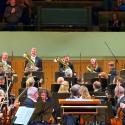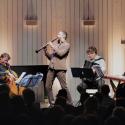This programme looked like a non-starter on paper, a long sequence of short Bartók dance settings, followed by a second half that was dominated by works for children from Bartók and Kurtág. But it worked, largely thanks to Cédric Tiberghien’s conviction in these short works and his ability to make imposing and decisive statements with a minimum of musical material.
The programme of the first half was organised chronologically, from the 15 Hungarian Peasant Songs of 1914-18, through the 8 Improvisations on Hungarian Peasant Songs of 1920 to the Piano Sonata of 1926. That allowed Bartók’s increasing freedom in his use of the folk material to give a sense of progression. Tiberghien is a regular visitor to the Wigmore Hall and knows how to make the most of the piano and the acoustic. Although nuanced in his touch, he is never reticent, and takes every opportunity to project clear lines and textures. Tiberghien’s motoric left-hand technique is particularly valuable in the 15 Peasant Songs, giving the music a real sense of weight and presence. His rubato is sometimes extreme, but always feels intuitive, especially in the Improvisations, which in his hands live up to their name. Bartók’s piano music is all about rhythm and attack, and Tiberghien knows when to emphasise the music’s percussive qualities. At its most extreme, that involves continuous martellato attacks, with his two hands reaching high above his head from one chord to the next. But even then, we hear shading and colour in differing weight of each chord.
The notes here are easy to play but the sense of the music is difficult to express
Similar textures prevail in the Piano Sonata, although here the longer spans allow development and growth. Stravinsky is a clear presence in much of this music. Paul Griffiths tells us in his programme note that Bartók was influenced by the recent success of Les noces, and Stravinsky’s angular ostinatos are often heard high in the right hand. But the driving accompaniments are all Bartók, and that muscular left-hand technique again becomes a defining quality of Tiberghien’s performance here. The slow movement proved a rare moment of blandness; without the strong rhythmic profile of the outer movements, and too tasteful to indulge in overt sentiment, Tiberghien found little to say.
Further, but mostly earlier, folk dance settings were presented in the second half, the Three Hungarian Folksongs from Csík of 1907 perhaps the most unaffectedly melodic of the evening. But the main feature was a sequence of movements from Bartók’s Mikrokosmos volume 5 interspersed with pieces from György Kurtág’s Játékok. The connections between the composers soon became clear, specifically in their respective relationships with the piano keyboard: both see it as an arena for invention, as physical and tactile as aural. Kurtág goes further than Bartók, but a sense of unpredictability pervades both men’s work. Occasionally, Kurtág’s extremes take the edge off Bartók’s otherwise radical ideas. Bitonality between the hands, for example, or running parallel fifths seem tame compared to a work made up solely of pianissimo glissandos, or another in which the pianist simply chops the keys with the side of his two hands. But the extended sequence had the effect of drawing the two composers together until, by the end, the only significant difference was Bartók’s focus on rhythm and Kurtág’s on texture.
Tiberghien is as fluent in Kurtág as he is in Bartók. The notes here are easy to play but the sense of the music is difficult to express. It requires a subtle theatricality, to allow each note to speak for itself and each silence (of which there are many) to have as much meaning as the sounds. Tiberghien achieves all this and much else besides. More Bartók-themed recitals from him would be most welcome, and so too further forays into this more adventurous repertoire.















Add comment